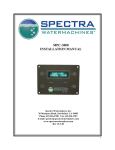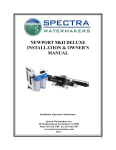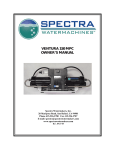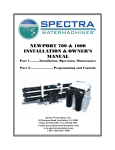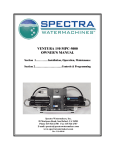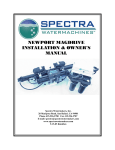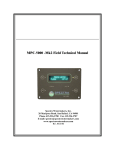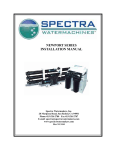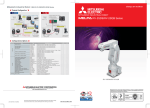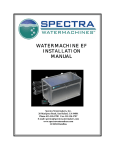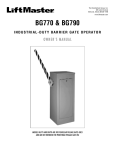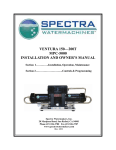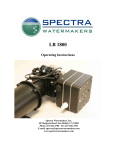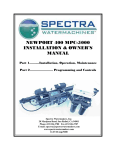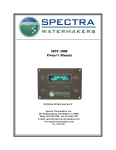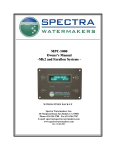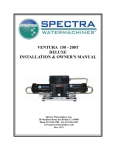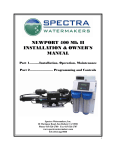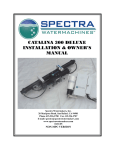Download Catalina 300 MPC 3000 User Manual
Transcript
CATALINA 300 MPC INSTALLATION MANUAL Spectra Watermakers, Inc. 20 Mariposa Road, San Rafael, CA 94901 Phone 415-526-2780 Fax 415-526-2787 E-mail: [email protected] www.spectrawatermakers.com Rev 09-20-04 1 Thank you for your purchase of a Spectra Catalina system. Properly installed it will provide years of trouble free service. Please pay attention to the installation instructions and the system layout. Like any piece of mechanical equipment the system will require inspection and service from time to time. Do not place the components in inaccessible areas that will prevent proper maintenance. If you are having a dealer install the system for you, review the location of the components to make sure that the installation will meet your approval upon completion. Catalina Installation Quick Start Important Details for Installer 1. The system must have a dedicated sea water inlet to guarantee a solid flow of water to the system. The inlet should be as low in the boat as possible and with a scoop type forward facing thru-hull fitting installed. 2. Follow the wire gauge charts in the instructions! Using larger wire than specified is acceptable. 3. The MPC control must have DC power continuously to achieve the full benefits of the fresh water flush system. The domestic fresh water pressure must be on and the fresh water tank level maintained. Calculate 3 gallons (12L) per flush for the Catalina 300. 4. The MPC 3000 control must be de-powered (DC power off) after the system is put in storage “pickled” where a storage chemical or antifreeze is run through the system. 5. If you are separating the Clark pump/membrane assembly, please review the high pressure tube assembly instructions. Improper assembly will cause failure! 6. Run test, then “sea trial” the complete system before assuming the system is operational. If the boat is in fresh or dirty water, see “Dry testing the system.” 7. Spectra dealers are responsible for educating the vessel owners on the operation and maintenance of the system. We request that you “walk through” the installation with our customer. 8. Please have the owner fill out the warranty card. The warranty is void if it is not registered. 2 Table of Contents Installation Page Number Getting Started.....................................................................................................................4 Installation Basics................................................................................................................5 Component Placement.........................................................................................................6 Plumbing..............................................................................................................................9 Parker Tube Fitting Assembly Procedure..........................................................................13 Electrical............................................................................................................................14 Operation New Systems Start Up and Testing ...................................................................................22 Dry Testing ........................................................................................................................25 Normal Start Up Using the Auto Run ...............................................................................26 Automatic Fresh Water Flush Cycle .................................................................................27 Emergency Operation ........................................................................................................28 Long Term Storage Procedures .........................................................................................29 Winterizing ........................................................................................................................32 Maintenance.......................................................................................................................33 Suggested Spares ...............................................................................................................37 Membrane Pressure Vessel Relocation .............................................................................38 Troubleshooting Procedures ..............................................................................................40 Spectra MPC-3000 Operation Guide.................................................................................42 3 Getting Started Unpack the system and inspect it to make sure that it has not been damaged in shipment. Refer to the shipping list for your system to make sure you have received all of the components listed. Do not discard any packaging until you have found and identified all of the parts. The small installation parts are listed on the cellophane bags’ pick list. We will not be held responsible for shortages and or freight damage that are not reported within thirty days of the ship date. Next, study the system layout diagram, component photos and descriptions before beginning your installation. This will assist you in understanding the function of each component. Layout the system. Before starting the installation identify the location where each module and component will be placed. Insure that there is proper clearance around the components for removal of filters and system service. Also check to make sure you have adequate tubing and hose before starting so additional parts may be ordered. Check to see that the MPC cable is long enough to reach from the display location to the main module. Catalina 300 MPC shipping list: Catalina Magnetic Drive Feed Pump Module • High Pressure Clark Pump and Reverse Osmosis Membrane Module • Fresh Water Flush Module • Duel filter assembly. • MPC-3000 control system with remote panel. • Catalina Installation Kit • Service Hose Kit • 5/8” Hose (25’) • Catalina 300 shipping list: Catalina Feed Pump Module. • High Pressure Clark Pump and Reverse Osmosis Membrane Module • Fresh Water Flush Module • Duel filter assembly. • Analog Monitor Panel With Control Switches and control harness. • Catalina Installation Kit • Service Hose Kit • 5/8” Hose (25’) • 4 Installation Basics • • • • • Read the directions! Avoid tight hose bends and excessive runs. Use heavy gauge wire. Install feed pump as low as possible. Use a dedicated thruhull with scoop type strainer. Thruhull Not Supplied. Flow Thru-hulls It is mandatory that a dedicated 3/4” forward facing scoop type intake thru-hull and seacock be installed. Install the intake for the system close to the middle and as far below the water line as possible. Thru-hulls in the bow area are susceptible to air intake in rough conditions. Sharing a thru-hull with another system is not acceptable and will void the warranty. Sharing a thru-hull can introduce unforeseen problems such as intermittent flow restriction, air bubbles, and contaminates. For racing boats and high speed power boats above 15 knots a retractable snorkeltype thru-hull fitting is preferred to be able to pick up water away from the hull. Do not install the intake close to or downstream of a head discharge. Install as far below the waterline and as close to center line as possible to avoid contamination and air induction. The brine discharge through-hull should be mounted above the waterline, in or just above the boot stripe to minimize water lift. Double clamp all hose connections below the waterline. Pipe Fitting Instruction Plastic to plastic fittings should have 3 to 4 wraps of Teflon tape and will thread almost all the way in. Avoid getting dirt or debris into the piping or hoses during assembly. A small bit of debris can stop the system! Avoid getting tape over the end of fittings that might get into the system. To insure this does not happen, leave the very first thread uncoated. Avoid restrictions or long runs on the inlet side of the plumbing from the thru hull to the main feed pump module. Prevent tight bends and excessive elbows. Any restrictions will hamper system performance. Secure the piping away from moving objects such as engine belts and hatches. Prevent chafe on the tubing as required. Test and inspect all piping and hose clamps after several hours of operation. Wiring • • Pay attention to wire size or system performance will be impaired. Perform wiring to UL, ABYC, CE or applicable standards. 5 Component Placement Refer to the Plumbing Diagrams Strainer Mount the strainer in an accessible area close to the intake throughhull that can handle water spillage during service. Extra care during assembly must be taken to avoid air leaks from the strainer. Use the supplied “Quick Block” and wire tie for mounting. Fresh Water Flush Module The fresh water flush module should be located between the intake strainer and the feed pump Module and as low as possible in the vessel. It should be mounted with the filter housings vertical and accessible for changing filters. Allow 2” below the filter housing for removal. Do not install over electrical equipment. Remove filter bowls for access to the screw holes in the mounting plate. The unit contains a 50 Micron prefilter, charcoal filter for the flush water, flush solenoid and three way intake service valve. Optional Zeta Guard The optional Zeta-Guard Water treatment system should be installed between the fresh water flush module and feed pump, to effectively treat all incoming water to the system. Consult your Zeta handbook for specific directions. Feed Pump Mount the feed pump module on a horizontal or vertical surface up to 4’ above the waterline. It is preferable to mount as low as possible. If mounted on a vertical surface mount the pump head down. 6 The filter assembly is installed between the feed pump and the Clark pump membrane module. Mount vertically in a location with 2” below the filter bowls. Locate where water spillage during filter change will not be a problem. Plumb the water in on the left and water out on the right. If you have an MPC control plug the color coded cables into the respective sensors. There are two accumulator assemblies, one is located in the feed pump module to facilitate the fresh water flushing process and the other is located between the feed pump module and the Clark pump pressure vessel unit. Plumb the second as shown with the analog pressure gauge in one port. The pressure is preset at the factory so no adjustment is necessary. The MPC-3000 controller is the “brain” of your watermaker system; it is programmed to control and monitor your entire watermaker system. No changes to the wiring should be necessary, unless you wish to install additional options or lengthen any of the cables to suit your installation needs. If this is the case, please refer to the respective page in this manual for additional information on where to connect additional devices, as well as current and voltage limitations of the board. ALWAYS mount this unit away from any possible water spray, drips, hose connections, etc. Keep the control box cover on at all times. 7 Remote Control Panel The remote control panel can be mounted anywhere that’s dry and convenient. Cut a 4 9/16” (116mm) wide by 2 7/8” (68mm) high opening for the panel. Locate in an area that is easily visible and easy to manipulate the buttons. Use only Spectra approved remote cable. The cable is not standard LAN cable or phone cord. Clark Pump/Membrane Module The Clark pump/membrane module comes complete with a mounting system. Be sure to use the supplied washers on the rubber feet. Use it as a template for drilling the mount holes. Mount in any position but leave access to the pressure relief valve on the Clark pump. Install in an area that maintains a temperature below 120F (50C). A cool location is preferable. Keep this unit within the 15’ (4.5M) reach of the wires from main feed pump module. This unit may be placed as high in the boat as you desire. Make sure that the area around and under the pump does not have any water sensitive equipment. Water will be spilled during any repairs or if a leak occurs. Membrane Pressure Vessel Mounting The Clark pump and membrane assembly has been pre-assembled at the factory. If it is necessary to disassemble this module and mount the pressure vessel remotely use guidelines (High pressure tube assembly) in back of the manual. Use only approved Spectra tubing for assembly. 8 Diversion Valve and Salinity Probe (MPC VERSIONS) The diversion valve and salinity probe is supplied as an assembly. Mount this assembly near or on your pressure vessel. The assembly should be oriented with the salinity probe down. Make sure to install the watertight boot over the salinity probe. Product Water to Product Dump Line to the Brine Discharge on Clark Pump Salinity Probe Note Orientation Plumbing From the inlet thru hull to flush module and from flush module to pump module inlet use supplied clear 3/4” (19mm) spiral suction rated hose. Use the braided 5/8” hose on the discharge of the pump module The outlet of the filter assembly on the main module to the Clark pump assembly is under pressure. Use the supplied braided clear vinyl hose rated to 150 PSI (11 bar). Install the supplied accumulator and gauge between the filter and the Clark pump per photos. From Clark pump brine discharge connector use supplied 5/8” (15.9mm) clear braided vinyl hose. Route all hoses and tubes to prevent kinks and restrictions. Secure piping away from moving objects such as engine belts and hatches. Prevent chafe on tubing as required. Test and inspect all piping and hose clamps after several hours of operation. 9 300 Systems Piping Specification From the Clark pump brine discharge connector use the supplied 5/8 (15.9mm) clear braided vinyl hose. Install the supplied accumulator and gauge between the filter assembly and Clark pump. The outlet of the feed module to the Spectra high pressure pump assembly is under pressure. Use the supplied braided clear vinyl hose rated to 150 PSI (11 bar). From the inlet thru hull to the flush module and from the flush module to the pump module inlet use the supplied clear 3/4” (19mm) spiral suction rated hose. 10 Fresh Water Flush Module Run a feed line from the domestic cold pressure water system to the 1/2 hose barb on the fresh water flush assembly. This needs to be active when the boat is unattended for the fresh water flush system to function properly. The domestic fresh water pump must be able to deliver 2.5 gallons per minute at 25 PSI. Connect the wiring harness and heat shrink butt splices. Fresh Water In From Domestic pressure System. 1/2” (12.7MM) Hose Water Out To Feed Pump Module. Service Port For Maintenance. Sea Water In From Strainer. 11 Product Water tubing MPC– 3000 Version Product water tubing is 1/4” (6.3mm) parker tubing pre-plumbed from the membrane into the electric diversion valve. The diversion valve will dump product water into the overboard brine stream until good quality is measured by the MPC-3000 control. Product water is then diverted into the fresh water tank. You will need to route the product water from the valve into the top of the tank. Install a tee in the water fill or tap a pipe thread into an inspection port in the top of the tank. Do not feed the water into a manifold or bottom of the tank. Make sure there is no restriction in this plumbing. Product water to tank Diversion Valve Solenoid and Salinity probe assembly Quick Disconnect Fitting Brine Discharge Route the Brine discharge from the quick disconnect fitting to location above the waterline using the supplied 5/8” (15.9MM) hose. 12 Parker Tube Fitting Assembly Procedure Body Step 1: O-ring Spacer Single grab ring for 1/4" & 3/8" tube Use 2 grab rings for 1/2" tube Nut Tubing Dissemble fitting components 1/2" max Step 2: Install the Nut first then use the bevelled side of the Spacer to push the Grab Ring onto the tube no more than 1/2". Slip the O-ring over the tube to hold the Spacer in place. If the Grab Ring is pushed too far, trim back the tube so about 1/4" of tube extends past the O-ring. Step 3: Gently fit the tube into the body and loosely thread on the nut. Be careful not to cross-thread the nut 1/2" tube should not bottom out in the fitting to allow full compression of the O-ring Step 4: Hand tighten the nut. DO NOT OVER TIGHTEN! DO NOT USE A WRENCH! The tube should not come out if pulled by hand. If it does, tighten the grab ring tabs. 1/4", 3/8", 1/2" Parker Tube Fitting Assembly 13 Electrical Installation First , locate and identify the components that are to be integrated into your system. Review the MPC control and harness assembly to identify each of the leads and their function. Make sure that the harness will reach each component of the Spectra watermaker system before it is installed. It may be easier to relocate a component rather than extending the harness. Locate the MPC control central to the system components to keep the wire runs short and direct. The control harness assembly consists of the following, Power feed in 4’ (1.2M) Pump feed (factory connected) Pressure switch leads 6” (1.8M) Fresh water flush feed 15” (4.5M) MPC display cable 50’ (15.2M) Stroke sensor, Salinity probe and Diversion valve feed 15’ (4.5M) Do not connect any power to the control until you have finished all connections and are ready to test the system. The control is pre-wired and requires only a few connections to be made. Pay particular attention to the main power wiring or system performance will be compromised. Main Power feed should be connected to an uninterruptible power source and should be circuit protected with a fuse or circuit breaker. Mount the main power terminal block in a dry location between the control and the power source to keep the wire run short as possible. Install terminal block cover after making your connections. Wire lengths are for a pair of wires from the source to the terminal block location. Catalina 300 Systems 12V Fuse or circuit breaker 25A Use # 10 Gauge wire (6MM) to 10 Feet (3M) Use #8 Gauge wire (10MM) to 15 Feet (4.5M) Use #6 Gauge wire (16MM) to 20 Feet (6.1M) Use #4 Gauge wire (25MM) to 35 Feet (10.6M) For 24V systems you double the length of the pair of wires. Use a 15A fuse or circuit breaker. 14 MPC Control and Wiring Harness Manual Control Switch Control Box Power Cable Filter Sensor Harness Pump Power harness With vacuum switch leads MPC Control Harness Fresh Water Flush harness Stroke Sensor Diversion Valve Wire Salinity Probe Cable Clark Pump Harness 15 Route the pump feed terminal block near your feed pump location. Mount the terminal block and connect your feed pump to the block. Install the terminal block cover. Connect the two push on connectors to the vacuum switch. Route the control cable through the boat to the MPC display location. Be careful not to damage the connector. Plug this into the back of the control. The displays must be mounted in a protected location, out of direct sunlight, and away from spray or dripping water. Commands to the system can be entered at any panel. Each remote control display panel can accommodate an external alarm buzzer to provide audible alerts in the event of a fault or at the end of certain timed cycles. Use only the buzzer units supplied by Spectra Watermakers, as current on the LCD buzzer terminal is limited to 20 MA, any excessive load may damage the controller or remote display panel. Connect the buzzer RED wire to the terminal marked +POSITIVE, connect the buzzer BLACK wire to the terminal marked –NEGATIVE on the back of the remote display panel. There are currently two types of display options available: Liquid Crystal Diode (LCD) display, which is dark lettering on a backlit background, or an optional Vacuum Florescent Display (VFD), which are bright characters on a dark background. The VFD demands more power from the MPC controller, and currently, only one VFD can be run at a time. You can run one VFD and two LCD’s, or three LCD’s at any time. 16 Pressure Sensors The pressure sensors mount on the prefilter housing to monitor system pressure and differential pressure across the filters. Simply route the wires and plug them into the respective color coded sensors. If the wire leads for the sensors must be extended, you must use a minimum 18 AWG 3 conductor twisted and shielded marine grade wire. Make a waterproof, soldered splice connection to the new wire, and seal the splice in waterproof heat shrink tubing. The Water is inlet is plumbed to the left hand (red) side of the assembly as shown. Water out on the right, green side. The filter assembly may be re-oriented in the bracket if required. Water in Water out Stroke Sensor The stroke sensor snaps into the side of the end block of the Clark pump. If the wire leads for the sensor must be extended, you must use a 3 conductor, twisted and shielded marine grade wire. Make a waterproof, soldered splice connection to the new wire, and seal the splice in waterproof heat shrink tubing. Caution! Make certain that no extra strands are free to make contact with other conductors or components. Integrity of the sensor wiring is critical. If the stroke sensor must be removed, use a pen knife to find and depress the opposing clips holding the sensor to the block. 17 Diversion Valve and Salinity Probe (MPC VERSIONS) The diversion valve and salinity probe is supplied as an assembly. Locate the diversion valve wires and splice the remaining two conductor cables with the supplied butt splices. These are heat shrink connectors so you can seal them after splicing. Product Water to Tank Product Dump Line to the Brine Discharge on Clark Pump Salinity Probe Note Orientation Remove Plug and Install Adapter for Brine Dump See Parker assembly instructions next page. 18 Fresh Water Flush Module Route the single two conductor harnesses to the fresh water flush module and splice the wires to the solenoid wires. Heat the splice connectors for sealing. Connection of Optional Accessories 19 Connection of Optional Accessories Use of any external devices not approved by the factory may cause permanent damage to the controller and is not covered by the Spectra warranty. Accessory outputs are limited to 2 amps maximum load! Do not connect motors, pumps, etc to accessory outputs. Optional Z-Guard System: Detailed instructions are included with the Z-Guard kit. Connect to the “Aux1” and “GND” terminals of the MPC board. Ultraviolet Sterilizer: Detailed instructions are included with the sterilizer kit. The UV sterilizer lamp module and ballast unit should mount vertically, with the product water inlet at the bottom, outlet at the top. The ballast wires plug into the end of the bulb in the lamp module. The ballast RED wire connects to “STER” terminal on the MPC board, and the ballast BLACK wire connects to the “GND” terminal. If the wires must be extended, use minimum 16AWG wire. External Buzzer(s): In addition to the external buzzer(s) installed at each remote control display panel, a buzzer unit may be installed at the control box. The buzzer RED wire connects to the “BUZZ” terminal on the MPC board, and the buzzer BLACK wire connects to “GND.” Tank Switch Operation: The MPC controller can be set up to use your tank switches in two ways. For normal operation (using either Manual Run mode or Auto Run mode) simply connect the switches to the Tank1 and Tank2 connections on the MPC board. If only one switch is to be used, connect a jumper across the unused tank connection. Note that the switch must be installed in a position that will cause it to close (short) when the tank is full. In Manual or Auto Run mode, the system will stop producing water when both tank switches are closed, perform a fresh water flush, and shut down. Jumpered for only 1 switch To Tank 1 Switch Tank 1 Connection Tank 2 Connection 20 Automatic operation : Automatic operation for land based systems may be achieved by installing a low point tank switch and a high (full) tank switch. Tank 2 switch is be the low point or system on and tank switch 1 will be the high point system off switch. The system should then start when the tank low switch opens and shuts off when the tank one or high point switch closes. The unit will perform a FW flush after the run cycle and default into the five day flush cycle. How it Works: Press and hold the “Auto Run” button for 5 seconds– the display will read “AUTO FILL MODE”. The system will begin operation and produce water, filling the tank. Eventually the water level will rise until it reaches the “maximum” switch– at this time, the display will read “TANK/S FULL”; the system will at this point stop producing water, perform a fresh water flush, and then go into a 5-day flush cycle storage mode. The display will cycle “TANK/S FULL” and “FLUSH TIMER INTERVAL”, indicating the time remaining until the next flush occurs. As you use the water in your tank, the water level will drop until it reaches the “minimum” switch– at this time the system will ‘wake up’ out of storage mode, sensing that the minimum tank level has been reached, and will begin to produce water again until the water reaches maximum. 21 New System Start-Up and Testing Avoid running the system if the vessel is in contaminated water, such as in a harbor or canal. The system should be fully run tested before leaving port. It is preferable to sacrifice a filter by running the system in turbid water rather than waiting to get offshore to discover a problem or deficiency in the installation. If the location or weather prevents proper testing refer to the section “Dry Testing.” Warning! Damage may occur if the purge sequence is bypassed and the membrane is pressurized with storage chemical in it. 1. First Check That: • Thru-hull valve is open • Power is on. If you have an AC system both the AC power and the DC control voltage to the unit needs to be on. • Domestic fresh water system must be on. 2. Open pressure relief valve 1/2 turn ! 3. Power up the system • Alarm will sound - • Push the Alarm /Display button to silence alarm 22 4. Press Auto Run Button The system will go into a start mode and the feed pump will start shortly after. The system should prime within 60-90 seconds. Check the strainer and the brine discharge for water flow. There should be no bubbles anywhere in the intake hoses and the feed pump should sound smooth after priming. If the feed pump continues to sound rough, find the reason before continuing! Inspect the system for leaks. Note: If you must stop the purge sequence for any reason, the control will default back to the beginning of the purging mode to protect your system. If you wish you can bypass the purge sequence and initiate a normal start. Pressing both “Auto Run” and “Stop” simultaneously anytime during the purge sequence will bypass the purge sequence and enable a normal start. 5. After the purge sequence. The control will alarm with the message “Close pressure relief valve” - Close the valve and proceed by pressing “ Auto Run.” 6. The system is now running under pressure and making water. The display will read “purging product water.” This mode dumps the product water overboard for ten minutes in case there is any residual chemicals in the membrane. Carefully inspect for leaks over the entire system! Shut down the system and repair any leaks you find. 7. The system is now in the operational mode. You may start and run you system as you desire. You will not have to go through the purging mode unless you “de-power” the system. If you do, you can bypass the purging mode by pushing “Stop” and “Auto run” buttons at the same time. It is best to use the auto-run button which defaults to the automatic fresh water rinse. If you shut down the system from the stop button then use the auto store button to effect a fresh water flush cycle. 8. Check that the system is operating within its normal parameters. Compare with the chart on the next page 23 Product Flow Will produce 12.5-14 GPH (48-55LPH) Salinity This may not show any lit bars on a new system. One bar represents 100 PPM. System rejects water higher than 750 PPM. Feedwater Pressure Pressure range 80-110 PSI (5.5-7.5 BAR) . Filter Condition Clean filters on first alarm as soon as convenient. 24 Dry Testing With Artificial Ocean If it is not possible to test run the system with the boat in the water testing may be accomplished with an artificial ocean. Purchase enough aquarium salts to make 5 gallons (20 liters) of salt water. Make sure that the domestic water system is powered up and that there is water in the tank. Confirm that the Charcoal filter is installed in the Fresh water flush module and that the domestic water line had been installed and all valves are open. 1. Open Pressure Relief Valve. 2. Power up the control system. 3. Press both “Auto Run” and “Stop” to bypass the purge sequence. If the motor starts, stop immediately and press the Auto run and stop button again until you get a message PURGE MODE BYPASSED. 4. Press the Auto Store button and allow the fresh water flush system to cycle through its timed operation. Cycle the auto store system 5 more times to purge all of the storage chemicals out of the system. 5. Hook up your service hoses per the service diagram and photos. Route them into a 5 gallon (20 Liter) bucket. Disconnect the product tube from the diversion valve and using another short piece of tube route the product water feed into the test bucket. 6. Turn the valve on the fresh water flush module from “Run” to “Service.” 7. Press auto flush one or two more times to get enough water into the bucket to properly mix your salt water. Mix the salt until it goes into solution. If you are using a hydrometer mix the water to be 34,000 PPM. Close the pressure relief valve and start the system using the “Auto Run” Button. 8. Run and test the system for as long as possible. During the run test carefully inspect for leaks. Check all of the system parameters to make sure the system is operating correctly. Do not allow the water in the bucket to get above 120F (50C). 9. Store the system per the “Storage” instructions. Outlet Service Port Inlet Service Port 25 Normal Start Up Using the Auto Run Button • Press Auto Run button once and the system will prime and run for 1 hour. The display reads “AUTO RUN MODE” then “STARTING” with a 30 second priming countdown timer. After the prime, the display reads “AUTO RUN MODE” with a countdown timer. An hour of run time is added, up to 12 hours, with each successive momentary press of the Auto Run button. An hour can be added at any time. The display shows the default readout unless there is an alarm condition. Successive presses of the Alarm/Display button will scroll through the displays starting with “GPH PRODUCT.” Upon auto shut down by the timer or by the optional tank full float switches, the system will automatically fresh water flush and re-flush every 5 days. • Pressing the Stop button stops the sequence at any time with no flushes. Normal Operation • For optimum performance, Auto run the system as long as possible at one time. Never let the system sit with salt water in it. Never allow continuous air leaks in the intake. Normal Shut Down • If the system was started using the Auto Run button, the system will shut off on its own when the selected run time is over and will auto flush every 5 days. • Pressing the Stop button at any time will shut off the system with no auto flush function. • The optional tank float switches will shut off the system from any mode. If the system was started by the Auto Run button the system will flush and then re-flush every 5 days. If the system was started by the Start/Stop button it will do a 1 time flush. The display will read “TANK/S FULL.” Once one of the tank float switches opens, the alarm and “TANK/S FULL” display will cease on its own. Note that if “TANK/S FULL” is displayed, the system cannot be restarted. 26 Automatic Fresh Water Flush Cycle Warning! Proper understanding of the Spectra flush system and the vessel’s fresh water system configuration is mandatory for extended automatic flush cycles. The flush cycle must not be allowed to drain all the fresh water from the vessel or damage to the vessel’s systems may occur. • Make sure there is enough water in the fresh water supply system to supply the watermaker for more than the expected time of operation in the “re-flush every 5 days” mode. The 300 requires 3 gallons (13 liters) . • Make sure that the pressure water supply is on and will stay on during the flush mode (If this is not possible contact your certified dealer.). • Make sure that the pressure relief valve is closed. It should be closed if the system was just used to make water. The auto flush may not operate if the valve is open. • The power for the system must remain on during the auto flush mode. Turning off the power will disable the auto flush function and damage may occur. • Pressing the Auto Store button will engage a flush and then the 5 day flush cycle. The flush pump starts and the flush water solenoid opens for 5 minutes and then shuts down the display reads “FRESH WATER FLUSH” with a countdown timer and then will read “FLUSH TIMER INTERVAL” and the countdown timer will reflect the number of hours until the next flush. • Pressing and holding the Auto Store button for 3 seconds will engage a 1 time flush. The system flushes as described above but will not re-flush every 5 days. Display will read “FRESH WATER FLUSH” with a countdown timer, then the default display when finished. • Pressing the Stop button will cancel the auto flush mode. 27 Emergency Operation • In the event of an MPC control failure, the system may be operated manually using the manual feed switch on the MPC control box. • For manual start up, switch on the feed pump using the feed pump switch. Shut the unit down if the Clark pump does not cycle. Shut down if air is continuously present in the intake line or if the feed pump is excessively noisy. The automatic safety controls are disabled in manual mode. • Always discard the product water for the first few minutes of operation. The initial product water from the system may not be potable. Taste the product water before sending to a tank. • In manual operation, the salinity control is inoperative. Product water is available either directly from the membrane product water out or at the diversion valve brine outlet. You will have to bypass the diversion valve with the parker tubing. Disconnect product fitting. Remove check valve and reconnect the Brine tube to the check valve as shown. Connect Product tube to diversion valve. Activate manual switch. 28 Long Term Storage Procedures Watermakers are best run continuously. When not in use, biological growth in the membrane is the leading cause of membrane fouling. A warm environment will cause more growth than a cold environment. The auto fresh water flush system will greatly reduce biological growth but may not stop it completely in certain conditions. The 5 day re-flush feature allows the system to be shut down without any service procedures for extended periods of time but it doesn't replace performing a storage procedure for long periods of non-use. If an optional “Zeta Guard” water treatment system is installed in the system, the 5 day re-flush will maintain the system as long as unchlorinated pressurized fresh water is provided. System Storage or “Pickling” If the system is to be left unused for more than 2 weeks, perform the following storage procedure. The procedure introduces a chemical compound into the system that prevents biological growth. This procedure requires de-chlorinated water which can be made with the Spectra’s charcoal filter. Charcoal filters last a maximum of 6 months once wetted. Spectra SC-1 a special storage compound used by the US Navy. It is formulated to be compatible with the modern engineering plastics and composites in the Spectra pumps. Do not use any substitute except propylene Glycol, SC-1 Storage Compound has to be mixed at a ratio of 1 Spectra container to 3 gallons (12L) of fresh water to have the proper solution. An average of 2 gallons (8L) of water is in a 300 system . Caution! Avoid contact with skin, eyes, or lungs with the storage chemical. 29 Storage Procedure: • Step 1: Flush the system twice. Use the “Auto Flush” button on the LCD display, once the first flush has been completed, press “Stop” to cancel the 5 day interval timer, then press “Auto Flush” again. • Step 2: Remove the quick disconnect fitting from the brine discharge outlet of the Clark pump, and replace with a quick disconnect from your service kit, fitted to a hose, and lead the hose to a 5 gallon bucket. • Step 3: Press “Auto Flush” again to fill the bucket with fresh unchlorinated water: 1 gallon for 300 systems. • Step 4: Connect a hose, using the garden hose barb fitting from your service kit, to the service port of the fresh water flush module. Lead the hose into the bucket. Turn the service valve on the fresh water flush module 180°, so the intake is now coming from the bucket. • Step 5: Mix the storage chemical compound into the water in the bucket. • Step 6: Make sure the pressure relief valve on the Clark pump is Open (unpressurized). • Step 7: Use the “Feed Pump Manual” switch on the MPC control box to turn on the feed pump. Circulate the storage chemical in the system for approximately 10 minutes. Turn off the switch when finished. Clean Up: • Remove the quick disconnect from the Clark pump brine discharge, and replace the original hose that leads to the thru-hull. You may at this point, if you choose to, pump the bucket dry by using the feed pump switch. Stop when the bucket is empty. • • Turn the service valve 180° back to its original position, and remove the service hose. Turn off the power to the system and the MPC control. 30 31 service hose to service port of FWF module, lead hose to bucket, and turn service valve 180° Step 4: Connect a Step 5: Mix SC-1 into bucket. brine discharge, and replace with service hose leading to bucket Step 2: Remove Step 6: Make sure pressure relief valve is open. Step 8: You’re done! switch to activate pump, run for 10 minutes Step 7: Use feed pump manual Press “Auto Flush” to fill bucket with desired level of fresh water. Press “Start/Stop” when done. Step 3: display. Press “Start/Stop” when the flush is done, to cancel the 5 day timer. Then press “Auto Flush” to flush the system a second time. Press “Start/Stop” again when finished. Step 1: Flush the system by pressing “Auto Flush” on the LCD Winterizing Warning! Only use potable water antifreeze (Propylene Glycol). Do not use automotive antifreeze (Ethylene Glycol). • Step 1: With the system running use your product sampling valve to divert five gallons (20 liters) into one or two containers. • Step 2: Connect a hose, using the garden hose barb fitting from your service kit, to the service port of the fresh water flush module. Lead the hose into the bucket. Turn the service valve on the fresh water flush module 180°, so the intake is now coming from the bucket. • Step3: Start the pump with the manual switch and flush the system with almost all of the product water. (leave about 2 cups or 1/2 Liter) • Step 4: Remove the quick disconnect fitting from the brine discharge outlet of the Clark pump, and replace with a quick disconnect from your service kit, fitted to a hose, and lead the hose to a 5 gallon bucket. • Step 5: Pour one gallon (4L) of Propylene Glycol into the bucket. • Step 6: Make sure the pressure relief valve on the Clark pump is Open (unpressurized). • Step 7: Use the “on manual” switch on the control box to turn on the feed pump. Circulate the chemical in the system for approximately 10-15 minutes. Turn off the switch when finished. Clean Up: • Remove the quick disconnect from the Clark pump brine discharge, and replace the original hose that leads to the thru-hull. You may at this point, if you choose to, pump the bucket dry by using the feed pump switch. Stop when the bucket is empty. • Turn the service valve 180° back to its original position, and remove the service hose. Alternative procedure: If it is not possible to run the system you may use the fresh water flush system to get the required de-chlorinated fresh water. First shut the intake thru hull. Confirm that the domestic fresh water system is on. Flush the system once. Remove the brine discharge fitting and install the brine discharge service hose. Flush the system until you get one gallon (4L) in the bucket. Proceed with step 6 and 7 above. Note: The product tube, strainer, and all associated hoses that are not subject to the glycol antifreeze should be drained of fluid. This may require compressed air. 32 Maintenance General Periodically inspect the entire system for leakage and chafe on the tubing and hoses. Repair any leaks you find as soon as practical. Some crystal formation around the Clark pump blocks is normal. Wipe down any salt encrusted areas with a damp cloth. The Seawater Strainer and 50 Micron Filter • The sea water strainer’s stainless steel element should be inspected, removed, and cleaned as needed. A clogged strainer or 50 Micron filter will cause the MPC control to alarm “Check Sea Strainer.” Be careful to ensure that the thru-hull is closed before disassembly and the seal and element are in place before reassembly. Put the screen up to a light for inspection. When the system is put into storage, remove, rinse, and reassemble dry to impede corrosion. Check frequently during operation. • The 50 micron filter needs to be properly maintained to protect the feed pump. Only use Spectra approved filters. These may be cleaned several times before discarding. The Prefilters • Service the prefilters as soon as possible after the first prefilter alarm sounds. When the second alarm sounds the system will shut down to prevent damage. If cleaning and reusing filter elements, clean when the first segment appears on the filter condition bar graph on the LCD display. • To service the filters shut off the thru-hull, open the housings, discard the old filters, Clean out the housing bowls, reassemble the housings with new 20 and 5 micron filter elements. The 5 micron filter goes downstream from the 20 micron. Leave dry until next startup. • Use only Spectra approved filters or you may void your warranty. The filters may be cleaned several times with a soft brush and water in a bucket. Occasionally, lightly lube the O-rings with silicone grease. Oil Water Separator (Optional) To install oil water Removal capability remove the supplied 20 micron filter element in the duplex filter set and replace with the 20 micron oil water separator cartridge. Replace this when the MPC alerts you with a “Service Prefilter” alarm. The Charcoal Fresh Water Flush Filter • Replace the charcoal filter element at least every 6 months. 33 The Membranes • The membranes need to be cleaned only when they have lost up to 15% of their capacity due to fouling or the product quality degrades. The leading cause of fouling is from biological growth that occurs when the system is left unused without flushing or pickling. Fouling from mineral scaling can happen during operation under certain sea water conditions, and from rust. Monitor the product salinity and feed pressure bar graphs for higher than normal readings for the conditions. Other conditions can cause high pressure such as cold feed water or clogged filters. Low product flow is usually due to low voltage, damaged feed pump or Clark pump. Look for all other causes before cleaning the membrane. Membrane life can be shortened by excessive cleaning. • There are two types of cleaners: acid and alkaline. The acid cleaner (SC-3) will remove mineral scaling. The alkaline cleaner (SC-2) is used to remove biological by-products, oil, and dirt particles that get past the prefilters. If membrane performance is reduced and they have not been pickled recently, cleaning with both chemicals is recommended. The acid cleaner should be used first. If the membrane fails to respond to both cleanings, this is an indication of another problem with the system, or that it is time to replace the membrane. Contact Spectra Watermakers before removing a membrane. Membrane Cleaning For normal cleaning, the SC-3 Acid Cleaning Compound is used first, then the SC-2 Alkaline Cleaning Compound. If known bio-fouling is present, the SC-2 may be used first. Using hot water if possible, up to 120° (45C) is recommended as it greatly enhances the ability of the cleaners to do their jobs. If the history of the system is unknown or has been left “unpickled” for an extended length of time and biological growth is present, it is recommended that the system is cleaned with SC-2, using an alternate source of unchlorinated fresh water before the system is run under pressure. A simple test can be performed to see if biological growth has occurred. Before running the system, remove the prefilters and examine their condition If the housings are full of smelly discolored water, the system was not properly stored. Install clean prefilters if they were bad. Next check the membrane. Detach the brine discharge hose and lead to a bucket. Open the pressure relief valve one turn, and manually run the system for 30 seconds. Examine the brine water: if it’s discolored and smells bad, perform an SC-2 cleaning with an alternate source of unchlorinated water before running the system pressurized. If the brine is fairly clean, the system can be purged, run normally, and checked for performance. Clean the membranes only if performance is reduced. Heating the water is preferable. One way to do this is to find a camp stove and use a large stainless steel pot to heat the solution in. The cleaning solution throughout the system will heat as it circulates in and out of the pot. An alternative is to heat the one or two gallons of initial water to 120° on the main stove before mixing in the cleaner and circulating it into the system. Periodically stop and reheat the solution. Perform the cleaning procedures while the ship is in acceptable sea water for purging and testing. 34 Note: Procedures are the same for the SC-2 and SC-3 cleaners Warning! The pressure relief valve on the Clark pump must be open for this procedure or membrane damage may result. Maximum pressure 50 psi. A Spectra Cleaning Compound (SC-2 or SC-3) must be mixed with fresh water at a ratio of 1 container of compound to 3 gallons (12L) of unchlorinated water to have the proper solution. An average of two gallons (8L) of water is already present inside a 300 system . This water has to be figured into the mixture. A 300 system will use 1 container of compound, Cleaning Procedure: • Step 1: Flush the system twice. Use the “Auto Flush” button on the MPC-3000 display, once the first flush has been completed, press “Stop” to cancel the 5 day interval timer, then press “Auto Flush” again. • Step 2: Remove the quick disconnect fitting from the brine discharge outlet of the Clark pump, and replace with a quick disconnect from your service kit, fitted to a hose, and lead the hose to a 5 gallon bucket. • Step 3: Press “Auto Flush” again to fill the bucket with fresh unchlorinated water: 1 gallon (4L) for 300 systems, Press “Stop” when the bucket has reached the desired level. • Step 4: Connect a hose, using the garden hose barb fitting from your service kit, to the service port of the fresh water flush module. Lead the hose into the bucket. Turn the service valve on the fresh water flush module 180°, so the intake is now coming from the bucket. • Step 5: Mix the cleaning chemical compound into the water in the bucket. • Step 6: Make sure the pressure relief valve on the Clark pump is Open (unpressurized). • Step 7: Use the “Feed Pump Manual” switch on the MPC control box to turn on the feed pump. Circulate the storage chemical in the system for approximately 25 minutes. Turn off the switch when finished. Clean Up: • Remove the quick disconnect from the Clark pump brine discharge, and replace the original hose that leads to the thru-hull. You may at this point, if you choose, to pump the bucket dry by using the feed pump switch. Stop when the bucket is empty. • Turn the service valve 180° back to its original position, and remove the service hose. 35 Salinity Probe Calibration: Salinity is a measurement of TDS, total dissolved solids in liquid: these solids will conduct electricity to varying degrees. A special probe is used, with two electrical contacts in it, to determine the resistance to the flow of electricity in the liquid. In the Spectra Watermakers systems, the salinity probe is located just before the diversion valve, at the output of the RO membrane. This way we can look at the salinity level of the product water before deciding to either reject the water or accept it and divert it into the holding tank. The salinity level in parts-per-million can be seen either through the salinity meter in the software, or a jumper can be added to the MPC board in the ‘calibrate’ position, where it can then be seen on the LCD display (rather than a bar graph). After adding the jumper, it may be necessary to cycle through the different LCD displays until the display reads ‘salinity.’ Procedure: 1. Locate the Calibrate jumper location on the MPC-3000 Board. Jump the terminals 2. Start the system and after the salinity stabilizes, test the product water with a calibrated hand held tester. 3. Locate the MPC calibration trimmer potentiometer on the board below the salinity probe jack. Adjust until the display PPM matches the PPM reading from the hand held salinity monitor. Turning the trim pot clockwise will lower the salinity reading, and counterclockwise will raise it. 4. Shut the system down and disconnect the jumper on the MPC board. If a hand held meter is not available you can remove the probe and dip it into a known calibrated solution. This can be obtained from Spectra. 36 Suggested Spares Short term cruising, weekends etc. We suggest a basic cruise kit. Kit consists of 3 ea, 50 micron ,20micron, and 5 micron filters and two SC-1 storage chemicals. Cruising 2 to 6 months at a time. Two basic cruise kits, One each replacement charcoal filter. One replacement feed pump head. Longer than 6 months, Additional filters, offshore cruising kit consisting of Clark pump seals, O-rings, tools and membrane cleaning chemicals. One replacement strainer screen, O-ring for strainer screen, O-rings for filter housing Spectra Watermakers parts list: Part Number SC-1 STORAGE CHEMICAL SC-2 CLEANER SC-3 CLEANER BASIC CRUISE KIT C 5 MIC FILTER 20 MIC FILTER 50 MIC FILTER CHARCOAL FILTER 6” STRAINER SCREEN OIL/WATER FILTER FEED PUMP HEAD 6” STRAINER O-RING FILTER HOUSING O-RING OFF SHORE KIT 20” MEMBRANE 40” MEMBRANE P/N FT-CHE-SC1 FT-CHE-SC2 FT-CHE-SC3 KIT-BCK-C FT-FTC-5 FT-FTC-20 FT-FTC-50 FT-FTC-CC FT-STN-6S FT-FTC-OW Contact Factory with Model and Voltage SO-STN-6SS SO-FHS-10H KIT-OFFSH FT-MB-20 FT-MB-40 37 Membrane Pressure Vessel Relocation Use ONLY Dayco Imperial Nylo-Seal 88-NSR-1/2 tubing for high pressure connections. Pay attention to the direction and flow path of the tubing before disassembly. Make sure that you reinstall the tubing in the same manner. Rotate the 90 degree high pressure tube fittings on the Clark pump for ideal tube runs. The high pressure fittings are typically pre-installed at the factory. These fitting seal with an O-ring and require no Teflon tape or pipe dope. Loosen the backing nut rotate the fitting and reseat the backing nut. Follow the high pressure tube connection instructions on the next page. Connect the tubes to one of the components, secure the tube runs, and then trim and connect to the other component. A 90 degree bend in a tube is better than a 90 degree fitting. A tube, when mounted, should have at least one gentle bend to allow for expansion. Do not connect a tube straight between hard mounted fittings. When connecting the tubes to their components, be sure to hold the fitting body with a wrench during the final tightening. Of special note are the stainless steel tube fittings on the membrane housing seal on an O-ring and should be seated all the way in. Hold the fitting with a wrench while installing the tube. The fittings on the Clark pump have an O-ring seal and can be re-oriented by backing out the Oring Stop nut. Rotate the fitting to align with the tube and tighten the nut just past hand tight. Do Not over tighten! 38 Spectra High Pressure Tube Fitting Assembly Use ONLY Dayco Imperial Nylo-Seal 88-NSR-1/2 tubing for high pressure connections. Carefully fit and measure the tubing before cutting with a sharp razor knife or hose cutter and remove any burrs. Minimum tubing bend radius is 6”. Route tubing away from excessive heat sources and secure from vibration and chafe. Have at least one shallow bend in a tube assembly after it is installed. Refer to figure 1. If a fitting has been dissembled, reassemble as illustrated. The notch on the ferrule must engage the inside of the nut properly for the nut to seat down fully. Once the tube is inserted the ferrule and nut will naturally align. Refer to figure 2. Insert tube fully into the fitting, it should go in 0.9”. Tighten the nut finger tight while moving the tube around to prevent binding. One thread should be showing under the nut. Secure the tube so it won’t back out when tightening. Refer to figure 3. Use 13/16” wrench to hold a straight body fitting or a 3/4” wrench for a 90º body, and a 7/8” wrench for the nut. Hold the body, recheck the tube insertion, then tighten the nut 1-1/4 turns. Use the index mark on the nut as a guide. The threads should be completely covered by the nut. The tube connectors can be disconnected and re-tighten several times. To reconnect, insert the tube and ferrule into the body then hand tighten the nut. Hold the body and tighten the nut with a wrench a little past where resistance is encountered. When correct, the nut should be tightened a little past where it was before disassembly. Always check for leaks. Index mark Straight thread Straight or 90 deg. 3/8" pipe thread Figure 1. Nut Ferrule Body Nut finger tight with 1 thread showing Cut tube square Figure 2. Black high pressure tubing Tighten 1-2/3 turns (10 flats of the nut) with a7/8" wrench after finger tight. Use index mark as guide No threads showing Figure 3. Insert tube 0.9" until it stops IMPORTANT! Hold fitting body with 13/16" wrench when tightening 39 Spectra Catalina Troubleshooting Procedures SYMPTOMS PROBABLE CAUSE REMEDY Feed pump runs constantly, will not turn off Manual override switches in “on” position Turn off manual switch on control box Feed pump runs with loud noise Intake blocked Air leakage in intake system Pump De-Coupled Check thru-hull valve Check sea strainer for leaks Check FWF module for leaks Check Accumulator for correct charge No lights or display, system does not operate - Remote display not connected - No power to control box - Check display cable connections at back of display and at control box - Check and reset main DC supply breaker - Check for voltage (12 or 24vDC) at control box power input studs - Try manual bypass switches; if pumps run, then control or Pumps run intermittently, cycling on/off System operating in flush mode (DC models) - System will time out, or manually stop with the Start/ Stop button Display activates, but pump will not run - loose or broken pump wire connection - bad pump relay - blown F3 or F5 fuse on MPC - tanks are full - Check wiring at terminal block inside MPC - Test power relay, replace - Replace fuse (mini automotive type ATM) - Check tanks– system cannot be started if tanks are full. System runs, no product water delivered to water tanks, GHP bar graph shows OK, “Good” LED activated - System runs, no product water delivered to water tanks, GPH bar graph shows OK, “reject” LED activated - diversion valve inoperative wiring fault. disconnected or broken product tubing diversion valve plunger stuck - Check wiring at diversion valve and inside control box - Check product tubing - Disassemble and clean diverion valve plunger or replace valve (contact factory) high salinity of product water, causing system to reject water salinity probe out of calibration or defective, bad cable chlorine damage to membranes pressure relief valve open - Check for low feed pressure, close pressure relief valve - Check for leaks at high pressure hoses - Test product water with handheld tester– if over 500ppm for 1 hour, contact factory Close Valve 40 Spectra Catalina Troubleshooting Procedures Error Messages SYMPTOMS “System stalled” (“system stalled” may alarm when using the control panel to run system for servicing with the pressure relief valve open– use manual override switch instead) PROBABLE CAUSE - pressure relief valve open intake thru-hull closed airlocked system no signal from stroke sensor pump de-coupled REMEDY - Close pressure relief valve - Check thru-hull - Verify stroke sensor fully inserted in pump - Check stroke sensor wiring at control box - Replace stroke sensor - Check accumulator for proper charge “High Pressure” - blocked brine discharge - fouled membrane - Check brine discharge - Clean membrane “Voltage Too High” “Voltage Too Low” - battery voltage too high or low - loose wires or poor connections - Charge batteries - Check charging voltage - Check power connections “Re-starting” - no signal from stroke sensor at startup. System Air-locked - See remedy above for “system stalled” “Check Fuse” (followed by fuse number) - blown fuse at circuit board - Replace fuse (mini automotive type ATM) - Look for cause “Service Prefilter” - clogged filters - loose or defective pressure sensor wires - Install new filters - Check sensor wiring “Ck Sea Strainer” - clogged strainer - dirty 50 Micron prefilter - Seacock closed - Clean strainer screen change 50 - Mic, Check through-hull and intake hoses “Salinity High” - high product water salinity - chlorine damage to membranes - defective salinity probe or cable, cable disconnected - Check for low feed pressure - Check for leaks at high pressure hoses - Remove and clean probe contacts check calibration. - Check cable connections - Clean membrane 41 Spectra MPC-3000 Operation Guide This document is a basic outline of MPC-3000 operations. It details what is seen on the LCD display during the various modes of operation. 42 Power On Power On OPEN PRESSURE RELIEF VALVE NOW Initial Startup Purge Mode Auto Run STARTING or 2:00 All Off, Aux1 On Pump2, Pvlv, Aux1, Aux2 When 30 seconds remaining, Pump2 Off, Pump1 On Start Stop Purging Active Circuits PURGING STORAGE SOLUTION 18:30 Pump1, Pump2, Aux1, Aux2 Countdown to 0:00 CLOSE PRESSURE RELIEF VALVE NOW Done All Off, Aux1 On Close pressure relief valve and press Start/Stop RUN HIGH MODE Start Stop Pump2, Pvlv, Aux1, Aux2, Ster Displayed for 10 secs STARTING Priming 2:00 PURGING PRODUCT 10:00 Making Water Bypass Purge Mode Auto Run and 4 GPH PRODUCT ٱٱٱٱٱٱٱٱٱٱٱ22 When 30 seconds remaining, Pump2 Off, Pump1 On Pump1, Pump2, Aux1, Aux2, Ster Pump1, Pump2, Dvlv*, Aux1, Aux2, Ster PURGE MODE BYPASSED Start Stop Simultaneously 43 Manual Run Mode Start Stop RUN HIGH MODE Displayed for 10 secs Priming Active Circuits Pump2, Pvlv, Aux1, Aux2, Ster STARTING 2:00 When 30 seconds remaining, Pump2 Off, Pump1 On Making Water GPH PRODUCT 4 ٱٱٱٱٱٱٱٱٱٱٱ22 Pump1, Pump2, Dvlv*, Aux1, Aux2, Ster *Note on Diversion Valve Operation: During a water making mode, a 60 second salinity check is performed; If salinity is within tolerance (<700ppm) for a continuous 60 seconds, the Diversion valve will open, and the “good” LED will be lit. If salinity is out of tolerance, the Diversion valve will close, and the “reject” LED will be lit. Salinity must drop below tolerance and remain within tolerance for a continuous 60 seconds before Diversion valve will open. Press Low Mode Start Stop RUN HIGH MODE Then press again Start Stop RUN LOW MODE And hold for 5 seconds STARTING 1:30 GPH PRODUCT 4 ٱٱٱٱٱٱٱٱٱٱٱ22 Pump2, Pvlv, Aux1, Aux2, Ster When 30 seconds remaining, Pump2 Off, Pump1 On Pump1, Dvlv*, Aux1, Aux2, Ster 44 Auto Run Mode Auto Run RUN AUTO MODE 01:00 HOURS Active Circuits Pump2, Pvlv, Aux1, Aux2, Ster Note: pressing Auto Run again will add time in 1 hour increments Priming Making Water STARTING 2:00 RUN AUTO MODE 0:59 HOURS When 30 seconds remaining, Pump2 Off, Pump1 On Pump1, Pump2, Dvlv*, Aux1, Aux2, Ster Countdown to 0 Flush FRESH WATER FLUSH 5:00 Pump2 Cycles On/Off* Fvlv, Aux1 Countdown to 0 Storage FLUSH TIMER INTERVAL 119:59 Aux1 Countdown to 0 Perform Flush Cycle Repeats Note: Pump2 Flush On/Off times (seconds), as well as Storage Time (hours), are programmable via internal software Storage Mode Auto Store Flush Storage STARTING 5:30 FRESH WATER FLUSH 5:00 FLUSH TIMER INTERVAL 119:59 Pump2, Fvlv, Pvlv, Aux1 Pump2 Cycles On/Off* Fvlv, Aux1 Aux1 Countdown to 0, repeat Flush. Cycle repeats. 45 Press and hold Auto Fill Mode AUTO FILL MODE Auto Run Active Circuits Pump2, Pvlv, Aux1, Aux2, Ster For 5 seconds STARTING 1:30 AUTO FILL MODE When 30 seconds remaining, Pump2 Off, Pump1 On Pump1, Pump2, Dvlv*, Aux1, Aux2, Ster Will produce water until Tank1 switch closes Auto Fill Mode If Tank1 (max) Tank/s Full Switch closes.. TANK/S FULL Pump2, Fvlv, Pvlv, Aux1 STARTING 5:30 TANK/S FULL FRESH WATER FLUSH 5:00 Pump2 Cycles On/Off* Fvlv, Aux1 Display will toggle “Tank/s Full” to “Fresh Water Flush” every 5 seconds Countdown to 0 TANK/S FULL FLUSH TIMER INTERVAL 119:59 Aux1 Display will toggle “Tank/s Full” to “Flush Timer Interval” every 5 seconds Countdown to 0 If timer reaches 0, another fresh water flush will be performed If Tank2 (min) switch opens, Timer will interrupt, and unit will go back into Auto Fill Mode (Production Mode) 46 Run-time Readouts Alarm Disp Pressing Alarm/Disp at any time during run cycle will cycle through the following readouts: GPH PRODUCT 4 ٱٱٱٱٱٱٱٱٱٱٱ22 Push and hold Alarm Disp Converts to Metric Metric LPH PRODUCT 15 ٱٱٱٱٱٱٱٱٱٱ68 Metric FEED WATER BAR 3 ٱٱٱٱٱٱٱٱٱٱ9 SALINITY LOW ٱٱٱٱٱٱٱHIGH FEED WATER PSI 50 ٱٱٱٱٱٱٱٱٱٱ150 PREFILTER GOOD ٱٱٱٱٱ HOURS TOTAL 000000 47 Active Circuits If Inlet Pressure > Max Pressure (150psi for Newport Systems) HIGH PRESSURE Shutdown, Audible Alarm Alarm LED lit If Stroke not sensed for 30 seconds: RE-STARTING 2:00 Pump1 Off, Pump2 On Countdown to 0, retry previous mode If still no stroke RE-STARTING 2:00 Pump1 Off, Pump2 On Countdown to 0, retry previous mode If still no stroke SYSTEM STALLED Shutdown, Audible Alarm Alarm LED lit If no Inlet; 10” of vacuum sensed at vacuum switch: Error Occurred CK SEA STRAINER Begin FWF Mode Fresh Water Flush FRESH WATER FLUSH 5:00 Countdown to 0 Shutdown CK SEA STRAINER Audible Alarm, Alarm LED lit If problem corrects itself, Audible alarm off FWF Mode: Pump2 cycles On/Off, Fvlv, Aux1 Shutdown, Audible Alarm Alarm LED lit 48 Active Circuits If DC Input voltage too low: VOLTAGE TOO LOW Begin FWF Mode To Shutdown If DC input voltage too high: VOLTAGE TOO HIGH If salinity probe bad or disconnected: SALINITY PROBE FAILED CHECK FUSE X If blown fuse Begin FWF Mode To Shutdown Shutdown Shutdown (Where ‘x’ represents number of blown fuse (1-5)) If Tank1 or Tank2 switch closed for 2 minutes: If Tank1 AND Tank2 switch closed for 2 minutes: No display, software registers that Tank1 or Tank2 is full. TANK/S FULL Depending on operating mode, system may at this point begin a fresh water flush, begin storage mode, or shut down. Refer to Operating Modes. 49 Active Circuits If salinity above tolerance: Reject lamp lit, 20 minute internal counter begins Dvlv Off If salinity above tolerance for 20 minutes:: SALINITY HIGH FLUSH 5:00 Begin FWF Mode Audible Alarm Alarm LED lit Shutdown SALINITY HIGH Aux1 50 CATALINA MOTOR (12V) EL-MTR-1/6D12 CATALINA MOTOR (24V) EL-MTR-1/6D24 MPC BOX FM-MPC-MPCB CATALINA FEED PUMP BRACKET FM-CT-PM CATALINA VANE PUMP 110 PL-PMP-110MAG PRESSURE TRANSDUCER (150 PSI) EL-SSR-150 HIGH PRESS. HOUSING BRACKET DUPLEX FT-FHB-10HD HIGH PRESSURE FILTER HOUSING FT-FTH-10H 1/4"MPT X 1/4" FPT ELBOW NYLON PL-MFF-1/4X1/4 3/4"NPTX5/8"HOSE BARB ELL NYL. PL-HBE-3/4X5/8 51 MPC CONTROL PANEL (VFD) EL-MPC-RMCDF HI REJECTION MEMBRANE 40" FT-MB-40 3/4"-16 ST X 1/2"TUBE FITT. ELL SS PL-MTE-3/4SX1/2 PLATE BRACKET END FM-PVB-PBE RUBBER MOUNT HD-RBP-RM 3/8"MALE NPTX5/8"HOSE BARB ELL NYL PL-HBE-3/8X5/8 PLATE BRACKET FM-PVB-PB 1/2" HIGH PRESSURE TUBE (DAYCO) PL-NLT-1/2HP 3/8" LOW PRESS. TUBE PL-NLT-3/8LP 52 3/8"MPT X 3/8" TUBE FITT. ST. PL-MTS-3/8X3/8P 3/8"NPT X 1/4" TUBE FITT. ELL. PL-MTE-3/8X1/4 1/4"MPT X 3/8"TUBE FITTING ELBOW PL-MTE-1/4X3/8P 1/8"FEMALE NPTX1/4"TUBE FITTING ELL PL-FTE-1/8X1/4P 1/8"NPT NIPPLE NYLON PL-NP-1/8N 1/4" HEX PLUG NYLON PL-HP-1/4N 3/8"MALE NPTX1/2"TUBE SS FITT.ST PL-MTS-3/8X1/2S MEMBRANE END PLUG FT-PV-EP 1/4" PLASTIC CK VALVE (M-F) PL-CKV-1/4M-F 1/4"MALE NPTX1/4"TUBE FITTING ST. PL-MTS-1/4X1/4P 1/4" DIVERSION VALVE 12V W/O VB PL-SLN-1/4D12VB 1/4" DIVERSION VALVE 24V W/O VB PL-SLN-1/4D24VB 1/4" HEX PLUG NYLON PL-HP-1/4N DIVERSION VALVE MANIFOLD SUB-NP-DVM SALINITY PROBE EL-MPC-SP 53 3/4" MPT X 3/8" TUBE FITT ELL PL-MTE-3/4X3/8P 3/8" LOW PRESS. TUBE PL-NLT-3/8LP 1/4"MPT X 3/8"TUBE FITTING ELBOW PL-MTE-1/4X3/8P 3/4"MPT X 3/4" HOSE BARB ELBOW PL-HBE-3/4X3/4 3/4NPTX1/2"HOSE BARB NYL ELL PL-HBE-3/4X1/2 LOW PRESSURE FILTER HOUSING FT-FTH-10L GARDEN HOSE CAP PL-GHF-GC 3/4" 3-WAY VALVE PL-VLV-3W3/4 3/4"MPT X 3/4" HOSE BARB ELBOW PL-HBE-3/4X3/4 FRESH WATER FLUSH MODULE BRACKET FM-NPC-IM CHARCOAL FILTER FT-FTC-CC 50 MICRON FILTER ELEMENT FT-FTC-50 3/4"NPT X 3/4" HOSE BARB ST. PL-HBS-3/4X3/4 S,P,/S.T. (ON-OFF) SWITCH EL-SWT-TK1 TOGGLE SWITCH BOOT SEAL EL-SWT-TSBHC TERMINAL BLOCK 65A. 2 CIRCUIT EL-TM-65A2 PRESSURE SENSOR CABLE EL-SSR-PSH 50' DISPLAY CABLE EL-MPC-CBL50 STROKE SENSOR & 1.5'CABLE EL-MPC-SC15 SALINITY SENSOR CABLE (15') EL-MPC-CBL15 54 STROKE SENSOR & 1.5'CABLE EL-MPC-SC15 3/8"NPT QUICK DISCNT. COUP. BODY PL-QDC-BD3/8 VACUUM SWITCH EL-SWT-VC 5/8" QUICK DISCNT. FITT. HOSE BARB PL-QDC-HB5/8 1/2"NPT X 3/8"TUBE FITTING ELL. PL-MTE-1/2X3/8P ACCUMULATOR TANK PL-ACC-TK 1/2"NPT X 5/8" HOSE BARB NYL ST. PL-HBS-1/2X5/8 1/2"NPT X 1/8"FPT HEX REDUCER NYLON PL-BSH-1/2X1/8N 1/2" CLOSE NIPPLE NYLON PL-NP-1/2N 1/2"MPT X 3/4" HOSE BARB ST. 1/4"MPT X 3/8"TUBE PL-HBS-1/2X3/4 FITTING ELBOW PL-MTE-1/4X3/8P 1/2" FPT X 1/4" FPT GUAGE TEE PL-TEE-1/2F1/4G 55 End block B HP-TB-VEB-B Valve block HP-TB-VB End block A Composite cylinder and base HP-TB-VEB-A Brine out HP-CYL-CCA Pressure relief valve HP-TB-BV Center block Feed in HP-CB-CB7,10,15,20 Stainless steel tube HP-CYL-SST Cylinder ring End Cap HP-CYL-R Clark Pump Front View HP-CYL-EC End block A Valve block End block B Reset button Composite cylinder and base Not on all units HP-TB-RSBT Alternate brine out High pressure in Test port Center block High pressure out Stainless steel tube Cylinder ring End cap Clark Pump Back View 56 5/16"-3 1/4" SS AH Bolts HD-CPS-5/16X3 Spool Assembly Exploded View Spool End Spool Seal Quad Ring Seal Spool Center Quad Ring Seal Spool Seal Relief Valve O-Ring Spool End SO-HPP-RV Annular Rings HP-TB-AR Spool Assembly KIT-HP-10VSA Relief Valve HP-TB-BV Annular Ring O-Rings Mount inside Valve Block SO-HPP-AR Valve Block 5/16"- 2 3/4" SS A.H. bolts Reset button and O-ring End block B Piston O-ring SO-HPP-SP, PS20 HD-CPS-5/162.75 Spool piston HP-TB-VSP,VSP20 HP-TB-SR Spacer ring Valve block SO-HPP-VB Valve bore O-ring Valve bore O-ring Spacer ring End block A Spool piston Brine port O-ring SO-HPP-VP Valve spool Pilot port O-rings Piston O-ring SO-HPP-PLP Reversing Valve End Blocks 57 Valve port seals SO-HPP-VP Pilot valve port seals SO-HPP-PLP Piston rod HP-CYL-3/4R,7/8R,1R Center block cylinder O-rings SO-HPP-ECCB Pilot spool O-rings (4) Mount inside block SO-HPP-PV HP-CB-PVS Pilot spool HP-CB-PPS Pilot valve pin SO-HPP-PS Pin seal O-rings Pilot orifice HP-CB-PO HP-CB-PVPS Pin seals HP-CB-PVCR Clip rings Center block Rod lip seals Mount inside block SO-HPP-PR7, PR10,PR15 Feed in Check valve port O-rings SO-HPP-CVP Check valve assembly Piston to rod O-rings (2) Inside pistons Glass rod models only Center Block Check valve SO-HPP-CVS O-ring Check valve seat HP-CB-CVS Check valve poppet HP-CB-CV Check valve spring Check valve washer Check valve retainer HP-CB-CVR 58 S.S compression fittings 1/2" SS tube Piston with seal HP-CYL-SST HP-CYL-PT PL-MTS-3/8X1/2S Composite cylinder and base HP-CYL-CCA End cap O-ring Cylinder end cap SO-HPP-ECCB HP-CYL-EC Cylinder Ring HP-CYL-R Cylinder Assembly Piston with seal S.S compression fittings 1/2" SS tube End plug O-ring End plug Composite cylinder and base Cylinder Assembly Early Models 59



























































